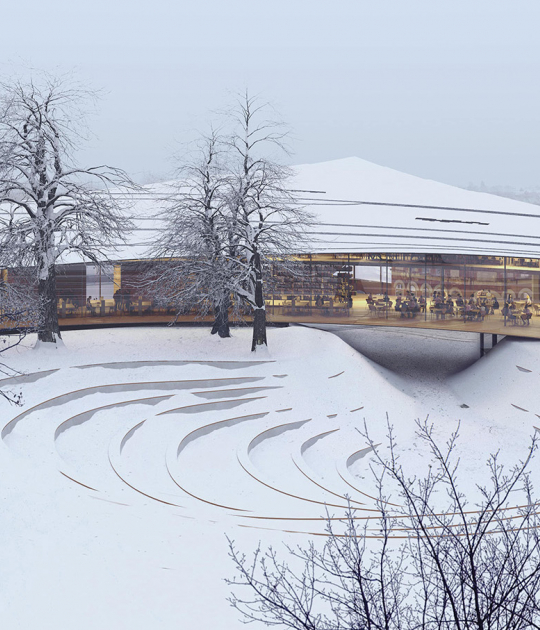
Kengo Kuma and Associates uses wood as the protagonist of the project. The skin of the house embodies the idea of a nest, with a natural finish of untreated wood that will age with the house, generating a variety of tones on the façade, depending on exposure to sun, rain and snow. Hand-cut wood from two species of trees from local forests was used. The wood skin disappears at specific points, giving way to vertical windows that flood the interior space containing all the functions of the house with natural light. The interior spaces are covered with large wooden boards with triangular geometries, once again giving great prominence to the wood.
The house is suspended from a large concrete roof thanks to a structure of steel cables. The metal staircase that gives access to the house is located on the front face of the house, suspended from the main structure. The façade uses a double-skin system, made up of white steel plates that act as waterproofing, and a layer made of small pieces of 120x300 mm oak and 120x500 mm larch wood. The pieces are arranged by hand to cover the entire house.

Suspended Forest by Kengo Kuma and Associates. Photograph by CAP Images.
Project description by Kengo Kuma and Associates
The site is located at the foot of the Jura Mountains in Switzerland, close to the deep forest. The project consists of a family house which would be part of the Jan Michalski Foundation. Its mission is to foster literary creation and the practice of reading. The house would be suspended from an existing concrete canopy already part of the foundation.
The design intention is to organically relate the different spaces of the house. It is a cocoon-like, gradual and continuous space containing all the functionalities. A corridor runs from the entrance to the main living space, where the floating balcony connects the interior with the surrounding environment. Then lateral apertures let the light come into the house.

The non-parallel shape obtained from triangular polygons will achieve higher rigidity as structure. The house is suspended from the vertex and fixed to pre-defined points around the columns of the concrete canopy. The entrance staircase is also suspended from the main structure. To reinforce the idea of a wrapping space, plywood panels in larch are coating the interior walls and ceilings, as a negative of the exterior wooden façade.
A local craftsman was involved in achieving a contemporary expression of the traditional wooden roof and façade system, transforming the roof into a filtration system. The waterproofing is made by white steel plates covering the main structure. Each one of the wooden pieces is manually cut and comes from local forests. Two different species and two different dimensions were used, 120×300 mm for the oak and 120×500 mm for the larch, placed in checkered pattern which is altered in a random and organic way. It was decided not to treat the wood so it will age with the house, generating shades diversity in the façade, depending on the sun, rain and snow exposure.


















































